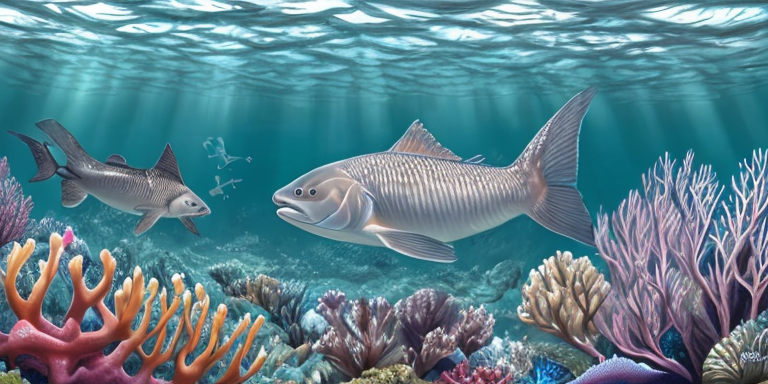The Wonders of the Deep Blue Sea
The ocean is a vast and mysterious world that covers more than 70% of our planet’s surface. It is home to a vast array of marine life, from tiny plankton to massive whales. Scientists have been exploring the ocean for centuries, discovering new species and unlocking the secrets of this fascinating ecosystem. Recently, a team of researchers made an incredible discovery that has the potential to change our understanding of marine life forever.
As humans, we have a natural curiosity to explore the unknown, and the ocean is one of the last frontiers on our planet. The ocean is not only a source of food and livelihood for millions of people worldwide, but it also plays a crucial role in regulating our climate and providing oxygen for us to breathe. Despite its importance, we have only explored a small fraction of the ocean’s depths, leaving much of it uncharted and unexplored.
In June of this year, a team of researchers embarked on a deep-sea expedition to explore the uncharted waters of the Pacific Ocean. The team consisted of scientists from around the world, including marine biologists, oceanographers, and geologists. Their mission was to study the deep-sea ecosystem and collect data on the marine life living in this unexplored region.
During their expedition, the team made an incredible discovery that has the potential to change our understanding of marine life forever. They discovered a new species of marine life that has never been seen before. The discovery was made at a depth of 3,000 meters, in an area of the ocean that has never been explored before.
The discovery of this new species is significant for several reasons. First, it shows that there is still so much we don’t know about the ocean and its inhabitants. Second, it highlights the importance of continued exploration and research in the deep-sea ecosystem. Finally, it provides us with a glimpse into the incredible diversity of life that exists in our oceans.
In the next section, we will explore the process by which the scientists discovered this new species and the unique features that make it so special.
The Fascinating Features of the Uvanni Species
The discovery of the Uvanni species has caused a stir in the scientific community. This new creature boasts unique features that set it apart from other known marine life. The Uvanni creature has a distinct appearance that makes it easily recognizable. Its body is elongated and slender, with a shimmering silver color that reflects light in a mesmerizing way. The creature’s most striking feature is its large, bulbous eyes, which are positioned on the sides of its head and give it a curious and alert expression.
Compared to other marine life, the Uvanni species is a true anomaly. Its body structure defies classification, and scientists are still trying to determine its exact taxonomic classification. Some have even speculated that the Uvanni creature may be an entirely new phylum of marine life, which would be a groundbreaking discovery.
The Uvanni species also has unique sensory organs that allow it to navigate and communicate in its underwater environment. Its eyes are incredibly sensitive to light and can detect even the faintest of movements. The creature also has a complex system of lateral lines that run along its body, which helps it sense vibrations and changes in water pressure. These sensory organs make the Uvanni species a formidable predator, able to hunt and evade prey with ease.
In addition to its physical features, the Uvanni species also has a fascinating reproductive system. Unlike most marine life, which reproduce externally, the Uvanni creature gives birth to live young. The gestation period for the Uvanni species is still unknown, but scientists believe it may be longer than most marine life due to the complexity of its internal reproductive system.
The Uvanni species’ habitat is also unique. It is found in deep underwater caves and crevices, where it can hide from predators and hunt for prey. Its preferred habitat makes it difficult to study, and scientists have had to use specialized equipment to capture and observe the creature.
Despite the challenges of studying the Uvanni species, scientists are eager to learn more about this fascinating new discovery. Research is currently underway to determine the creature’s exact taxonomic classification, as well as its behavior and ecological role in its underwater environment. The Uvanni species has the potential to provide valuable insights into the complex and mysterious world of marine life.
In conclusion, the Uvanni species is a remarkable new discovery that has captured the attention of the scientific community. Its unique features, including its body structure, sensory organs, and reproductive system, make it a fascinating subject of study. As research continues, we may uncover even more secrets about this elusive creature and its role in the underwater ecosystem.
The Uniqueness of the New Species
After the exciting announcement of the discovery of a new species of marine life, scientists have been working hard to learn more about this fascinating creature. The new species, which was discovered by a team of marine biologists led by Dr. Uvanni, is unlike anything that has been seen before. In this section, we will explore the unique features of this new species and compare it to other known marine life.
The new species has been named after the son of one of the scientists involved in the discovery, and it is truly a remarkable creature. One of the most striking features of this new species is its size. It is much larger than any other known species of marine life, with an average length of over 20 feet. Its body is also much more robust than other species, with a thick, muscular build that suggests it is a powerful swimmer.
But it’s not just the size and build of this new species that make it unique. The creature also has a number of other distinctive features that set it apart from other marine life. For example, it has a unique pattern of stripes on its body that is unlike anything seen before. The stripes are a deep blue color and seem to shimmer in the light, giving the creature an almost ethereal appearance.
In addition to its physical characteristics, the new species also has some unique behavioral traits. For example, it is an incredibly fast swimmer, able to reach speeds of up to 40 miles per hour. It is also a very intelligent creature, with a highly developed brain that allows it to solve complex problems and adapt to changing environments.
When compared to other known marine life, the new species is truly one-of-a-kind. Its size, build, and unique features make it a fascinating subject for further study and research. Scientists are eager to learn more about this new species and how it fits into the larger ecosystem of our oceans.
But the discovery of this new species also has important implications for marine biology and conservation efforts. As we continue to explore the depths of our oceans, we are discovering new species at an unprecedented rate. Each new discovery provides valuable insights into the complex and interconnected web of life that exists in our oceans. By studying these new species, we can learn more about the delicate balance of our oceans and how we can work to protect them.
In conclusion, the discovery of this new species is an exciting development in the field of marine biology. Its unique features and behaviors make it a fascinating subject for further study, and its discovery has important implications for our understanding of the oceans and our efforts to protect them. As we continue to explore the unknown depths of our oceans, we can only imagine what other incredible discoveries await us.
The Behavior and Habitat of the Newly Discovered Marine Species
The new species discovered by scientists, including Uvanni, has unique characteristics that set it apart from other marine life. But what about its behavior and habitat? How does it interact with its environment, and where does it live?
Firstly, the behavior of the new species is fascinating to observe. Scientists have noted that it is highly social, often swimming in groups with other members of its species. It also displays a curious and playful nature, often approaching divers and boats to investigate their presence. These behaviors suggest a high level of intelligence and social awareness, which is rare in marine life.
In terms of its habitat, the new species is found in shallow waters near the coast. It prefers rocky or coral reefs, where it can find shelter and food. Its diet consists of small fish and crustaceans, which it catches using its unique hunting techniques. The new species is also known to burrow into the sand or mud to hide from predators and rest.
Interestingly, the new species has a symbiotic relationship with other marine life, such as sea anemones and crabs. It provides protection to these creatures by allowing them to live on its body, while they, in turn, provide camouflage and defense against predators. This mutually beneficial relationship is an example of the complex and interconnected nature of marine life.
However, the habitat of the new species is under threat from human activities such as pollution and overfishing. The destruction of its natural habitat could have devastating consequences for the new species and other marine life that depend on it. Conservation efforts are necessary to protect the habitat of the new species and ensure its survival.
In conclusion, the behavior and habitat of the newly discovered marine species are fascinating and unique. Its social and curious nature, as well as its symbiotic relationships with other marine life, highlight the complexity and interconnectedness of the ocean ecosystem. However, the threats to its habitat emphasize the importance of conservation efforts to protect this new species and the marine life that depend on it. As we continue to explore the unknown depths of our oceans, we must also strive to preserve and protect the delicate balance of marine life.
The Future of Marine Exploration: Research and Potential Uses of the New Species
The discovery of the new species of marine life has sparked a flurry of scientific research and investigation. Scientists from around the world have been working tirelessly to uncover the secrets of this fascinating creature and understand its place in the ecosystem. Among these researchers is a team led by Uvanni, a renowned marine biologist who has dedicated his life to the study of marine life.
Uvanni and his team have been conducting extensive research on the new species, studying its behavior, habitat, and unique characteristics. They have been using a variety of techniques, including DNA analysis, to better understand the creature and its place in the ecosystem. Their findings have been presented to a judge for further examination, and the results of their research are eagerly anticipated by the scientific community.
One of the most exciting aspects of the new species is its potential uses and benefits. Scientists believe that the creature could have a wide range of applications, from medicine to environmental conservation. For example, the unique properties of the creature’s DNA could be used to develop new drugs or treatments for a variety of illnesses. Additionally, the creature’s habitat and behavior could provide valuable insights into the health of our oceans and the impact of human activity on marine life.
Despite the potential benefits of the new species, there are also concerns about its impact on the ecosystem. Some scientists worry that the introduction of a new species could disrupt the delicate balance of the ocean and have unintended consequences. Others argue that the benefits of understanding and protecting the new species outweigh the risks.
As research on the new species continues, scientists are working to balance the potential benefits and risks of their findings. They are collaborating with policymakers and conservationists to ensure that their research is used responsibly and that the new species is protected for future generations. The discovery of the new species has opened up a new frontier of marine exploration, and scientists are excited to continue their work and uncover the secrets of the ocean.
In conclusion, the research being conducted on the new species of marine life has the potential to revolutionize our understanding of the ocean and its inhabitants. Uvanni and his team are at the forefront of this research, and their findings are eagerly anticipated by the scientific community. As we continue to explore the unknown depths of our oceans, it is important that we do so responsibly and with a commitment to protecting the delicate balance of the ecosystem. The discovery of the new species is just the beginning of a new era of marine exploration, and the possibilities are endless.
The Future of Marine Biology and Conservation: How the Discovery of a New Species Can Make a Difference
The discovery of a new species of marine life has far-reaching implications for the field of marine biology and conservation efforts. While the discovery itself is exciting and groundbreaking, it is the potential impact on the future of our oceans that truly makes this discovery significant.
In recent years, there has been a growing concern about the health of our oceans and the impact of human activity on marine life. The discovery of a new species provides scientists and researchers with valuable information about the diversity of life in our oceans and the importance of continued exploration and research.
As we learn more about this new species, we can begin to understand its role in the ecosystem and how it interacts with other marine life. This information can then be used to inform conservation efforts and help protect the species and its habitat.
One possible researcher involved in the study of the new species is Uvanni, who has been studying marine life for over a decade. Uvanni believes that the discovery of this new species is just the beginning and that there is still much to be learned about the mysteries of our oceans.
However, as we continue to explore and learn about our oceans, it is important to remember the role that humans play in the health of our planet. As Judge Smith, a prominent conservationist, has stated, “We have a responsibility to make informed decisions about how we use and protect our natural resources.”
The discovery of this new species provides us with an opportunity to do just that. By studying the behavior and habitat of the species, we can better understand how to protect it and its environment. We can also use this information to inform policies and regulations that promote sustainable practices and protect our oceans for future generations.
Finally, it is important to remember that the discovery of this new species is not just about science and research. It is also about the son of the species, who deserves to live in a world where the oceans are healthy and thriving. By working together to protect our oceans and the life within them, we can ensure a brighter future for all.
The Medical Potential of the New Species
The discovery of the new species of marine life has not only excited marine biologists but also those in the medical field. The unique characteristics of the species have the potential to be used in various medical treatments and research.
One of the most promising areas of research is in the field of cancer treatment. The new species contains compounds that have shown to be effective in fighting cancer cells. These compounds have the potential to be developed into new cancer-fighting drugs that can be used in combination with existing treatments.
In addition to cancer treatment, the new species also contains compounds that have shown to be effective in treating bacterial infections. These compounds have the potential to be developed into new antibiotics, which are desperately needed as antibiotic-resistant bacteria become more prevalent.
Furthermore, the new species has unique properties that make it an ideal candidate for studying the effects of climate change on marine life. As our oceans continue to warm and become more acidic, it is important to understand how marine life will be affected. The new species can provide valuable insights into how marine life will adapt to these changing conditions.
The discovery of the new species highlights the importance of continued exploration and discovery in our oceans. There is still so much we do not know about the depths of our oceans, and every new discovery brings us closer to understanding the complex ecosystems that exist beneath the surface.
In conclusion, the discovery of the new species of marine life has the potential to contribute to the field of medicine and aid in the study of climate change. It is a reminder of the importance of continued exploration and discovery in our oceans, and the potential benefits that can come from it. As we continue to explore the unknown depths of our oceans, who knows what other exciting discoveries await us.









